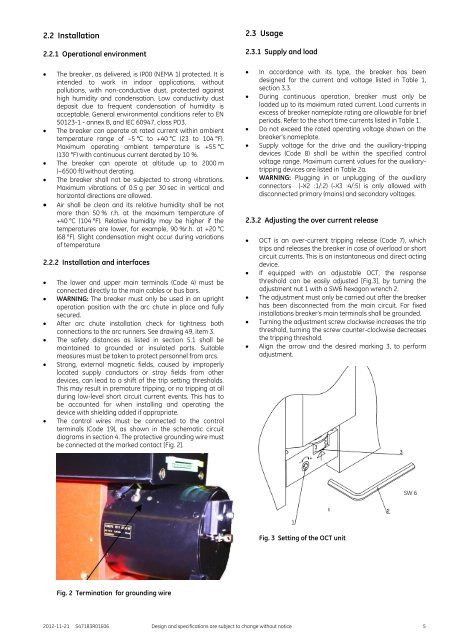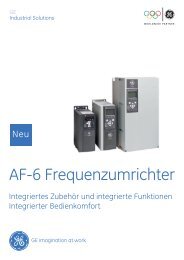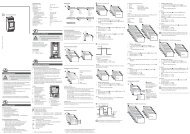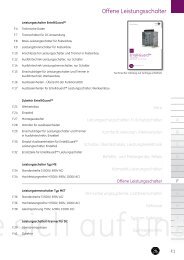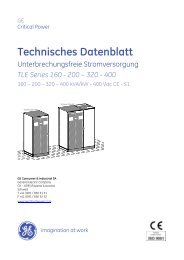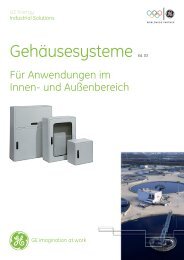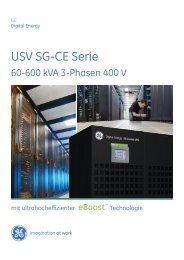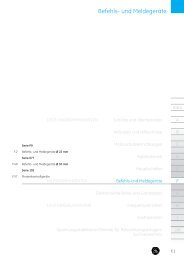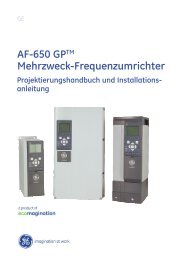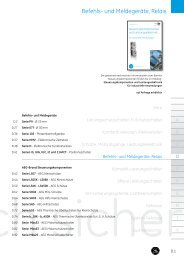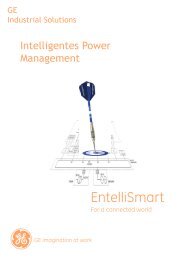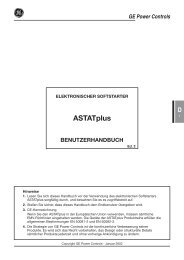GE Consumer & Industrial - G E Power Controls
GE Consumer & Industrial - G E Power Controls
GE Consumer & Industrial - G E Power Controls
Create successful ePaper yourself
Turn your PDF publications into a flip-book with our unique Google optimized e-Paper software.
2.2 Installation<br />
2.2.1 Operational environment<br />
<br />
<br />
<br />
<br />
<br />
The breaker, as delivered, is IP00 (NEMA 1) protected. It is<br />
intended to work in indoor applications, without<br />
pollutions, with non-conductive dust, protected against<br />
high humidity and condensation. Low conductivity dust<br />
deposit due to frequent condensation of humidity is<br />
acceptable. General environmental conditions refer to EN<br />
50123-1 - annex B, and IEC 60947, class PD3.<br />
The breaker can operate at rated current within ambient<br />
temperature range of –5 °C to +40 °C (23 to 104 °F).<br />
Maximum operating ambient temperature is +55 °C<br />
(130 °F) with continuous current derated by 10 %.<br />
The breaker can operate at altitude up to 2000 m<br />
(~6500 ft) without derating.<br />
The breaker shall not be subjected to strong vibrations.<br />
Maximum vibrations of 0.5 g per 30 sec in vertical and<br />
horizontal directions are allowed.<br />
Air shall be clean and its relative humidity shall be not<br />
more than 50 % r.h. at the maximum temperature of<br />
+40 °C (104 °F). Relative humidity may be higher if the<br />
temperatures are lower, for example, 90 %r.h. at +20 °C<br />
(68 °F). Slight condensation might occur during variations<br />
of temperature<br />
2.2.2 Installation and interfaces<br />
<br />
<br />
<br />
<br />
<br />
<br />
The lower and upper main terminals (Code 4) must be<br />
connected directly to the main cables or bus bars.<br />
WARNING: The breaker must only be used in an upright<br />
operation position with the arc chute in place and fully<br />
secured.<br />
After arc chute installation check for tightness both<br />
connections to the arc runners. See drawing 49, item 3.<br />
The safety distances as listed in section 5.1 shall be<br />
maintained to grounded or insulated parts. Suitable<br />
measures must be taken to protect personnel from arcs.<br />
Strong, external magnetic fields, caused by improperly<br />
located supply conductors or stray fields from other<br />
devices, can lead to a shift of the trip setting thresholds.<br />
This may result in premature tripping, or no tripping at all<br />
during low-level short circuit current events. This has to<br />
be accounted for when installing and operating the<br />
device with shielding added if appropriate.<br />
The control wires must be connected to the control<br />
terminals (Code 19), as shown in the schematic circuit<br />
diagrams in section 4. The protective grounding wire must<br />
be connected at the marked contact [Fig. 2].<br />
2.3 Usage<br />
2.3.1 Supply and load<br />
<br />
<br />
<br />
<br />
<br />
In accordance with its type, the breaker has been<br />
designed for the current and voltage listed in Table 1,<br />
section 3.3.<br />
During continuous operation, breaker must only be<br />
loaded up to its maximum rated current. Load currents in<br />
excess of breaker nameplate rating are allowable for brief<br />
periods. Refer to the short time currents listed in Table 1.<br />
Do not exceed the rated operating voltage shown on the<br />
breaker’s nameplate.<br />
Supply voltage for the drive and the auxiliary-tripping<br />
devices (Code 8) shall be within the specified control<br />
voltage range. Maximum current values for the auxiliarytripping<br />
devices are listed in Table 2a.<br />
WARNING: Plugging in or unplugging of the auxiliary<br />
connectors (-X2 :1/:2) (-X3 :4/:5) is only allowed with<br />
disconnected primary (mains) and secondary voltages.<br />
2.3.2 Adjusting the over current release<br />
<br />
<br />
<br />
<br />
<br />
OCT is an over-current tripping release (Code 7), which<br />
trips and releases the breaker in case of overload or short<br />
circuit currents. This is an instantaneous and direct acting<br />
device.<br />
If equipped with an adjustable OCT, the response<br />
threshold can be easily adjusted [Fig.3], by turning the<br />
adjustment nut 1 with a SW6 hexagon wrench 2.<br />
The adjustment must only be carried out after the breaker<br />
has been disconnected from the main circuit. For fixed<br />
installations breaker’s main terminals shall be grounded.<br />
Turning the adjustment screw clockwise increases the trip<br />
threshold, turning the screw counter-clockwise decreases<br />
the tripping threshold.<br />
Align the arrow and the desired marking 3, to perform<br />
adjustment.<br />
SW 6<br />
Fig. 3 Setting of the OCT unit<br />
Fig. 2 Termination for grounding wire<br />
2012-11-21 S47183R01E06 Design and specifications are subject to change without notice 5


